|
Monday, December 12, 2011
Progress Notes
The terrain and geology of Miller County seem to have interested geologists early on in our history. A few months ago I featured a geological assessment of our county which was quite detailed and complete written by geologists Sidney Ball and A.F. Smith entitled “The Geology of Miller County,” which you can review at this previous Progress Notes.
This week I am going to present another geological discussion of the county written over a century ago by one of the foremost geologists of the time, G. Frederick Wright.
Dr. Wright had become interested in our county after he read the report by Ball and Smith. The geological feature which interested Dr. Wright so much was Ball and Smith’s observation of the presence of a number of huge granite boulders “found in the valley of the Osage River near Tuscumbia, 40 miles further south than they had been heretofore noted in that vicinity.”
I asked board member Jim Clark if he knew of any of these boulders along the river. Jim is well acquainted with the river being an avid fisherman. Also, he learned much about the river from his father, Arthur Clark, who had worked on some of the Osage River steamboats. Jim told me that one area he remembered particularly was the Klug Slough south of Mary’s Home where a number of the large boulders can be found (photos 02 and 03).
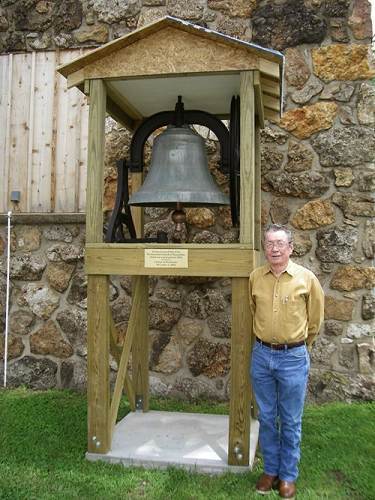
02 Jim Clark
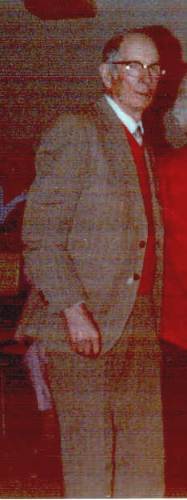
03 Arthur Clark
Dr. Wright was so interested in these boulders that he made a special trip to our county from Ohio to investigate for himself what to him seemed to be something very interesting. Here is Dr. Wright’s essay:
The Nation
A Weekly Journal
Devoted to Politics, Literature and Science & Art
VOLUME LXXVII
FROM JULY 1, TO DECEMBER 31, 1903
NEW YORK
NEW YORK EVENING POST COMPANY
1903
VOLUME 77, No. 2006
p.461
ANOTHER GLACIAL WONDER
Tuscumbia, Mo. November 25, 1903
So many remarkable phenomena in the northern part of the United States have been explained by the glacial period that it seemed as if we were nearly at the end of the wonderful story, but at the meeting of the Geological Society of North America in Washington last winter, Professor Buckley of the School of Mines at Rolla, Missouri, and Dr. Ball, who had been conducting the geological survey of Miller County, made an announcement really startling to that portion of the scientific public whose familiarity with the situation enabled them to appreciate its significance. The announcement made was that a number of granite boulders had been found in the valley of the Osage River near Tuscumbia, 40 miles further south than they had been heretofore noted in that vicinity. The facts seemed of sufficient importance to warrant a journey of 200 miles for their investigation. Investigation has increased rather than diminished the interest attaching to them (photos 04 and 05).
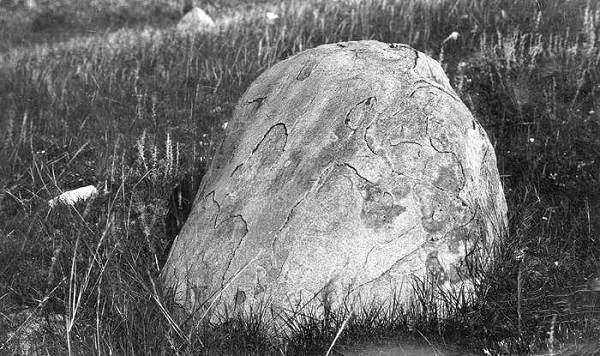
04 Granite Boulder
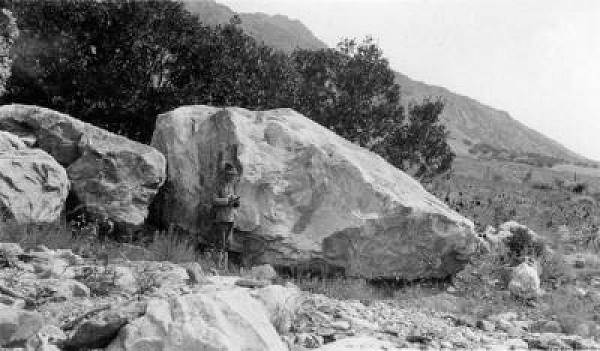
05 Granite Boulder
The glacial boundary across Missouri follows very closely the line of the Missouri River, except on the low lands in two or three counties between Jefferson City and Kansas City. North of this line, the country is completely enveloped with glacial deposits, including great numbers of granitic boulders from the vicinity of Lake Superior and the Northern part of Wisconsin and Minnesota. The course of the Missouri River itself is also worthy of attention. At Kansas City this great line of drainage makes a turn at right angles and pursues an easterly course for 300 miles. The obvious cause of this turn is that it meets here the first beginnings of the gentle uplift which is known as the Ozark Mountains. But the word mountains is hardly applicable, since there is merely a swell in the earth’s surface attaining an elevation of about 1,100 feet above the sea, or 1000 feet above the Missouri River at a point 100 miles south of it. From this watershed the drainage of several large rivers, of which the Osage is the principal, finds its way northward into the Missouri. The Osage River, however, rises two or three hundred miles to the west, far up in Kansas, running for a considerable distance parallel with the Kansas River above Kansas City, and not far from it. Tuscumbia lies in the trough of the Osage, 60 miles above its entrance into the Missouri.
A drive of forty miles across the country from California, about thirty miles west of Jefferson City, to Tuscumbia, shows a complete absence of glacial deposits, and leads over a picturesque country which was once a plain, but is now deeply channeled by numerous streams which have been at work from early geological ages. On approaching within a few miles of Tuscumbia, a scene of real grandeur unfolds itself before one’s eyes. The Osage River has cut a central channel in the magnesium limestone about 300 feet below the general level, and in this channel are innumerable side gorges which approach it on both sides at various angles. The other side of the valley, 10 or 15 miles away, has the appearance of a mountain range. On descending into this valley one finds the immediate trough of the Osage at Tuscumbia to be about half a mile wide, with perpendicular limestone bluffs on either side of 100 to 150 feet in height. Between the river and these limestone bluffs there are continuous old flood plains or terraces, now considerably above high water mark, furnishing very fertile farm lands (photos 06 and 07).
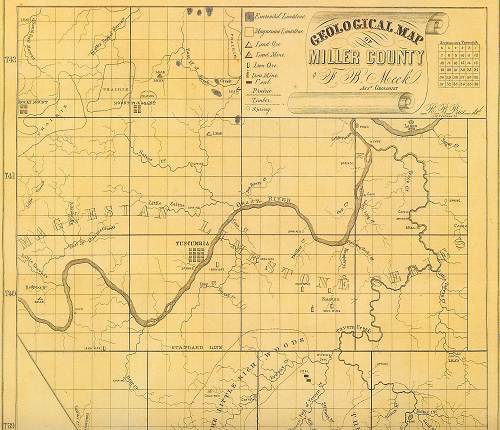
06 Osage River in Miller County
Click image for larger view
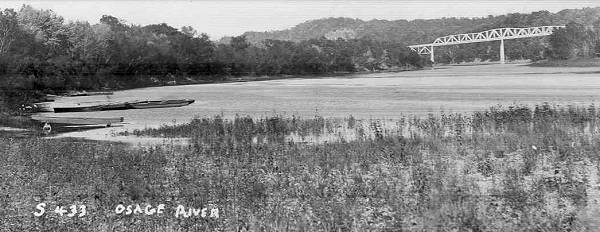
07 Osage River Bridge bluff view from Tuscumbia Landing
But the river itself is not flowing over a rock bottom. The abutments of the railroad bridge at Hoecker fourteen miles below were sunk forty feet below the bottom of the river before rock was reached (photos 08, 09 and 10).
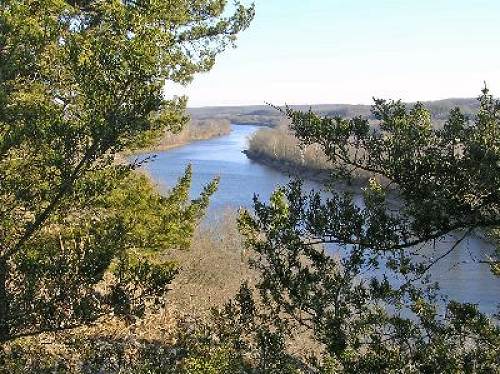
08 Overlook Bluff at Hoecker
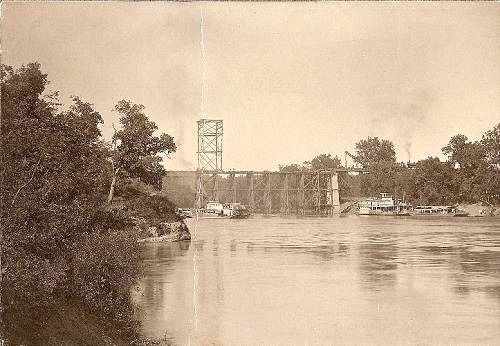
09 Hoecker Bridge Construction
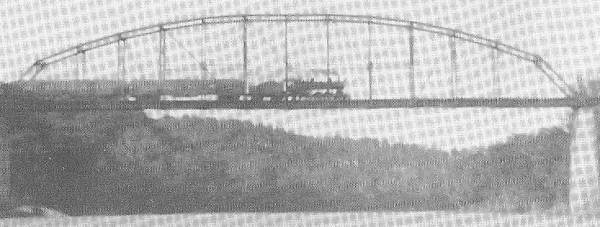
10 Hoecker Bridge Completed
The gradient of the river is only about one foot to the mile…very nearly the same as that of the Missouri.
Steamers ascend in high water as far as Osceola, a distance, as the river runs of 200 miles.
All this shows clearly enough the following vicissitudes in the river’s history:
During a very long period the drainage of this flank of the Osage uplift has been concentrated along the line of the Osage River, when the general elevation was somewhat greater than now. This period was protracted enough for the river to erode all this long tortuous, deep gorge, contributing the material to the Missouri, which carried it away to the sea. This process proceeded until the gorge was certainly 40 feet deeper than now. Then a subsidence of the region diminished the gradient of the stream and allowed it to silt up its channel to the present level, whereupon followed the remarkable facts connected with the glacial period of which we are now to speak.
At as many as nine places within a few miles of Tuscumbia, large granitic boulders from the far north have been found along the gravel terraces which line the Osage River. One, which I saw, measures 4X3 feet upon the surface, and extends an indefinite distance into the ground. Another, lying in one of the side gorges half a mile back from the river, would weigh fully half a ton, and was stranded at an elevation of about 75 feet above the river, which would be 150 feet above the Missouri. To account for the existence of these boulders in the gorge of this valley, but one theory is really open: they have been floated 60 miles up the Osage River on ice floes which had brought them down from the glacial region farther north (photo 11).
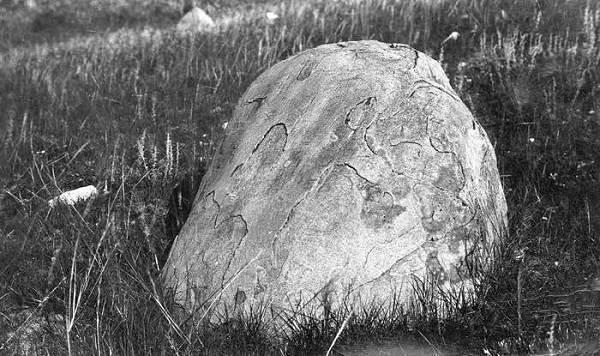
11 Granite Boulder
To produce such a drift up stream, it is necessary to imagine conditions under which the Missouri River would periodically rise nearly 200 feet, while the Osage River had not much increase of its water supply in the principal part of its drainage basin. Such a condition of things has many analogies in a small way. For instance, the Columbia River in Oregon often rises 30 or 40 feet when there is no corresponding rise in the Willamette. At such times the water of the Columbia sends a wave up the Willamette to Portland somewhat as the tide of the ocean goes up into an inlet. I well remember hearing a strange story when a boy, that the mill dam of Hubbardten Creek in Vermont had been carried away up stream. The explanation was that the Carleton River, into which the creek ran, suddenly rose while there was no corresponding rise in the creek. The mill-dam, not being protected from pressure below, was consequently easily drifted up stream. Under similar conditions the Missouri rising 200 feet, would float masses of ice up the Osage River to a distance of nearly 100 miles.
On turning our minds to the conditions connected with the close of the glacial period, we find that they fit in with those facts as a key fits the lock for which it is made. During the glacial period the drainage of all the region from the Hudson Bay southward was turned over into the valleys of the Mississippi and Missouri. Some 200,000 square miles of the drainage basin then contributing to the Missouri was covered with glacial ice. In the closing stages of the period it is estimated (and with much probability) that the ice was melting at the rate of from 15 to 20 feet annually, which, in addition to the annual rainfall (probably much increased) would make about ten times the amount of water now carried off by the Missouri River. During this last year the excessive rainfall of a single week through eastern Kansas and southern Iowa produced tremendous floods at Kansas City, raising the water thirty eight feet. It is easy to suppose that during the summer months in the closing stages of the glacial period there was an annual rise in the river of five times that amount, which would be sufficient to produce the phenomena we are considering with Tuscumbia.
This explanation required for the boulders at Tuscumbia is also of much assistance in our efforts to explain the vast amount of loess’s which has accumulated in the Missouri Valley. The deposits of this very fine loam, like that which covers southern Russia and borders the base of the mountains throughout Central Asia and China, rise in many places in a thickness of 200 feet above the river on either side, thinning out in both directions as one gets away from the stream. A controversy of considerable interest has arisen concerning the origin of this. The difficulty of providing water in sufficient quantities to account for the deposit had given great encouragement to those who would attribute it entirely to wind deposition, so that, notwithstanding the difficulties, many eminent geologists have adopted the wind hypothesis. But in the annual floods of such enormous extent in the Missouri Valley, which theoretically would occur during the closing stages of the glacial period, and which are now more definitely indicated by this drifting of large boulders so far up this southern tributary, we have the requisite vera causa which has been needed by those advocating the water hypothesis.
Special interest attaches to these phenomena from the supposed connection of the losses with the early history of mankind. The celebrated Lansing skeleton, concerning which so much has been written, is thought by many of the best geologists to have been buried at the base of the bluffs twenty miles above Kansas City before the deposition of the loess, thus connecting it with that stage of the glacial period which produced the enormous floods of which we have been speaking.
Note: Read more at the Wikipedia entry for the Lansing Man.
Without attempting to assign any definite date to this period, it is sufficient to have our attention directed to those significant vicissitudes through which the human race has passed in both Europe and America, which are connected with the glacial period. Either man is very ancient, or the vicissitudes connected with the glacial period are much more recent than were once supposed. Indeed, so many signs point to their recency that we need not be surprised to find the date of the civilizations of Babylonia carried backwards till it meets the period of the prevalence of glacial ice over northern Europe and North America, with outlying population existing in much the same conditions as those now surrounding the Eskimo in Greenland.
G. Frederick Wright
Professor Wright was an extraordinary man being not only a noted geologist but also a theologian as well as scientist. His biography is impressive:
G. Frederick Wright
(George Frederick Wright)
pages 110 - 111
The men most influential in promoting the advancement of society and in giving character to the times in which they live are two classes—the men of study and the men of action. Whether we are more indebted for the improvement of the age to the one class or the other is a question of honest difference of opinion; neither class can be spared and both should be encouraged to occupy their several spheres of labor and influence, zealously and without mutual distrust. In the following paragraphs are briefly outlined the leading facts and characteristics in the career of a gentleman who combines in his makeup the elements of the scholar and the energy of the public-spirited man of affairs. Devoted to the noble and humane work of teaching, G. Frederick Wright has made his influence felt in the school life of the State of Ohio, and is not unknown to the wider educational circles of the nation, occupying as he does a prominent place in his profession and standing high in the esteem of educators in other than his own particular field of endeavor, especially that of literature.
Professor Wright was born in Whitehall, New York, January 22, 1838, a scion of a sterling old family of the Empire State, being the son of Walter and Mary Peabody (Colburn) Wright. After finishing the usual elementary courses in the schools of his native town, young Wright entered Oberlin College, at Oberlin, Ohio, where he made a brilliant record and from which institution he was graduated with the degree of Bachelor of Arts in 1859, the same college conferring on him the degree of Master of Arts in 1862, in which year he was graduated from the Oberlin Theological Seminary. He was further honored in 1887 by Brown University conferring upon him the degree of Doctor of Divinity; also Drury College in 1887 conferred upon him the degree of Doctor of Laws. He was made a Fellow of the Geological Society of America in 1890.
When the Civil War broke out in 1861, he enlisted in the Union army and served his country faithfully for a period of five months, during the first year of the war.
Professor Wright was twice married, first on August 28, 1862 to Huldah Marie Day, whose death occurred in 1899. He was united in marriage with Florence Eleanor Bedford in September 1904.
The career of Professor Wright has been a busy and successful one, as only a cursory glance at his record will Show. He was pastor of the Congregational Church at Bakersfield, Vermont, from 1861-1872; he was then pastor of the church of this denomination at Andover, Massachusetts, from 1872-1881. From 1881 to 1892 he was professor of New Testament language and literature in the Oberlin Theological Seminary, also taught the harmony of science and religion at Oberlin, from 1902 to 1907, when he was made professor emeritus and retired on a Carnegie pension. He was assistant geologist on the Pennsylvania Survey in 1881 and 1882, and on the United States Survey from 1884 to 1892. He has been president of the Ohio Historical and Archaeological Society since 1907, in which he is doing a most commendable work. In pursuit of his investigations he has visited every portion of the north temperate zone. He was a pioneer in the investigation of the glaciers of Alaska, in 1886. He spent a summer in Greenland in 1894. Besides seasons spent in Europe and the Rocky Mountains, for fourteen months he traveled through China, Mongolia, Manchuria, Siberia, Turkestan, and the Caucasus and Lebanon mountains, gathering original information for the books he has published. At three different times he was invited to give courses of Lowell Institute lectures in Boston, numbering twenty-eight in all.
Both as pastor and professor, Mr. Wright won a reputation second to none of his compeers, being both an instructor and entertainer at the same time, a vigorous and independent thinker, fearless in his researches, and ever having the courage of his convictions. As a speaker he is logical, convincing and, at times, truly eloquent. A man of profound scholarship, he is familiar with the world's best literature and useful sciences, leaving no field uninvestigated, no region unexplored in the realms of the mind, ever keeping fully abreast of the times in modern thought and invention, and ever striving to inculcate such principles as makes for the amelioration of humanity in any way possible, being broad minded and progressive, altruistic and humanitarian in all that the terms imply.
As an author, Professor Wright stands deservedly high among modern men of letters, the products of his versatile and graceful pen having reached a world-wide and highly appreciative audience, his style being that of the master—clear, forceful, elegant, never prolific or uninteresting. He is the author of the following publications: "Logic of Christian Evidences," 1880; "Studies in Science and Religion," 1882; "The Relation of Death to Probation," 1882; "The Divine Authority of the Bible," 1884; "Glacial Boundary in Ohio, Indiana, and Kentucky"; "Ice Age in North America," 1889; "Charles Grandison Finney," 1891; "Man and the Glacial Period," 1892; "Greenland Ice Fields and Life in the North Atlantic," 1896; "Scientific Aspects of Christian Evidences," 1898; "Asiatic Russia" (two volumes), 1902; "Scientific Confirmations of Old Testament History," 1906; "Origin and Antiquity of Man," 1912. He has been editor of "Bibliotheca Sacre" since 1884; also editor of "Records of the Past," since 1905.
Professor Wright is essentially cosmopolitan in his ideas, a man of the people in the fullest sense, and a representative type of that strong American manhood which commands and retains respect by reason of inherent merit, sound sense and correct conduct. He has so impressed his individuality upon his fellow men wherever his lot has been cast as to win their highest esteem and become a strong and influential power in leading them to high and noble things. Measured by the accepted standard of excellence, he career has been eminently honorable and useful, and his life fraught with great good to humanity and to the world.
Transcriber's Note: George Frederick Wright died 20 Apr 1921 at Oberlin, Lorain County, Ohio (Ohio Death Certificate, Lorain County, volume 3662 certificate number 22650)
Miller County has had its share of important visitors throughout its history such as Professor Wright. Perhaps the most famous was Zebulon Pike who camped here on his exploratory trip to the west as part of the Lewis and Clark expedition. You can read more about Pike at this previous Progress Notes.
However, one visitor(s) to our county occurred much more recently in 1967 and caused quite a stir. It was the day that Claude Edwards had a visit to his farm by foreign aliens from outer space. Claude was the son of Arthur Edwards and grandson of George Edwards (photos 12, 13 and 14).
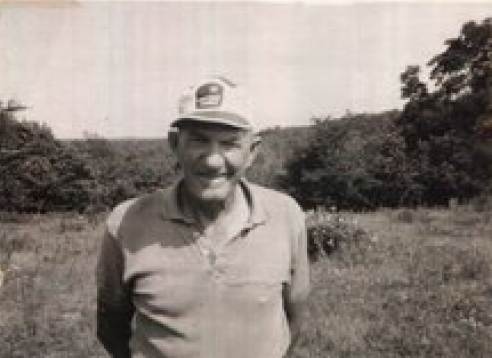
12 Claude S. Edwards
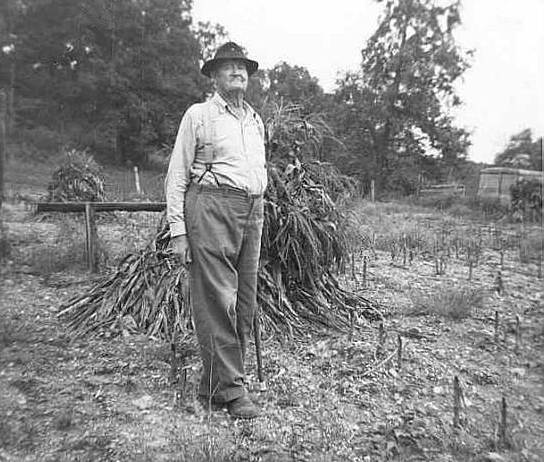
13 Arthur Edwards
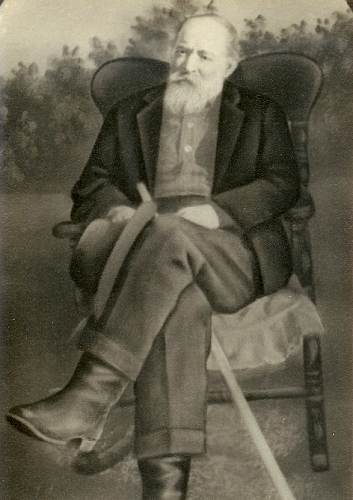
14 George Edwards
You can read more about the Edwards family on our own website.
The visit by aliens to Claude’s farm caused quite a stir at the time. Recently, I called one of Claude’s cousins, Doris Edwards Wyrick, to find out more about this story. She said that Claude Edwards left the Tuscumbia area early in life and went to Kansas City to live. After about thirty or more years he returned and lived on a farm which was located south of Highway 52 in Section 5 Township 40N Range 13W. This location is about five miles east of Tuscumbia on Highway 52 going toward St. Elizabeth and is near the original Edwards family home farm. Doris well remembers the day the aliens visited Claude and that Claude was interviewed by several of the local radio stations. Doris also said that Claude was not one to tell “stories.”
She verified that Claude was one of the sons of Arthur Edwards, and grandson of George Edwards, the original Miller County Edwards of this family. Claude was born in 1905 and died in 1990. Here is an old family photo of Claude and his family (photo 15):
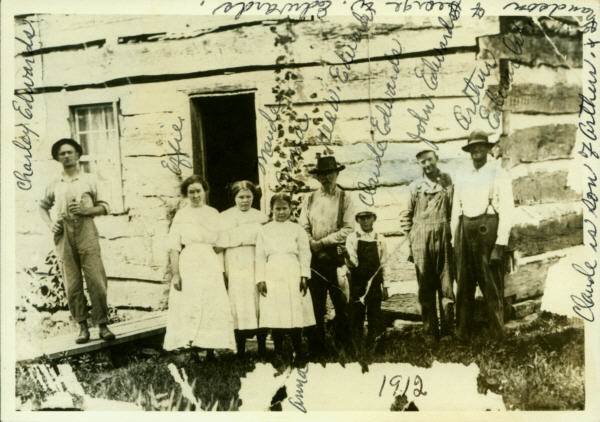
15 Some of George Edwards Family
In the photo Claude’s father, Arthur Edwards is on the far right and Claude is the small boy to the left standing next to George Edwards.
As a personal note I knew Claude’s father Arthur Edwards who lived for several years just a short distance down the hill from my home in Tuscumbia when I was a boy. And my mother also knew Claude before he left for Kansas City; however, I never met him.
I found on a quick web search that the internet has quite a number of references to the invasion of the Claude Edwards’ farm by “foreign aliens.” Copied below from one of these sites is the story (Note: some of the drawings were made by the author based on Claude’s descriptions).
Space Penguins of Tuscumbia, Missouri
Author: Rob Murphy
In the winter of 1967, a no nonsense Missouri farmer had a run in with a horde of strange, scurrying, entities from outer space that one could only describe as resembling “Green Space Penguins”.
On the bone chilling morning of February 14, 1967, a 64 year old farmer by the name of Claude Edwards woke up to attend to his duties on a remote parcel of land near Tuscumbia, Missouri. As the sun rose low on the horizon, Edwards bundled up to face the bitter day, never imagining that he was about to have a face to face encounter with the unknown.
Edwards was a simple, hardworking salt of the earth Midwesterner who had no time for any kind of foolishness regarding aliens, flying saucers or the like; so as his worn boots tramped across the icy, rock strewn slope that took him from his home to his barn., nothing could have shocked him more than to see what appeared to be a UFO sitting in one of his nearby fields.
Note: Here is a tracing Claude drew of the object (photo 17):
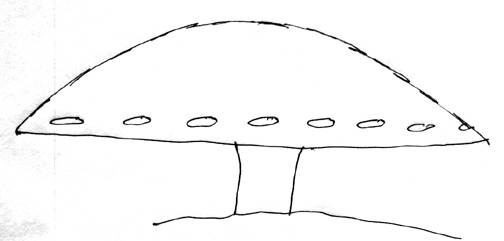
17 Claude's sketch of UFO
Edwards stated that before he saw this unusual object, the first thing that he noticed was that all of the cattle in his east field were gazing in the same direction (photo 18).
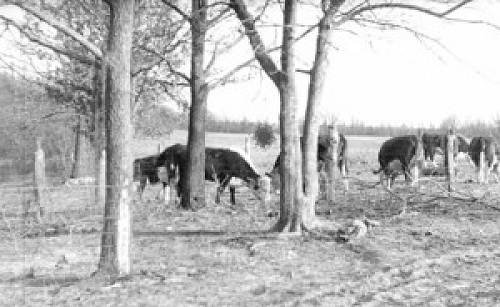
18 Cows in Field
Intrigued, Edwards followed their stares through a grove of trees and was astounded to see what he described as a massive, grayish green mushroom like object which was perched atop a circular tube in the meadow adjacent to his barn.
Almost as if on autopilot, the farmer continued to the barn; his eyes never leaving the UFO. He set down the feed bucket he had been hefting and latched the door shut. With his barn secured, Edwards then turned back toward the peculiar object occupying his field and that is when he saw something he would never forget…a group of tiny, strange creatures hastily swarming beneath the object. The ‘X’ in the next photo indicates approximately where the UFO was when Edwards first spied it (photo 20).
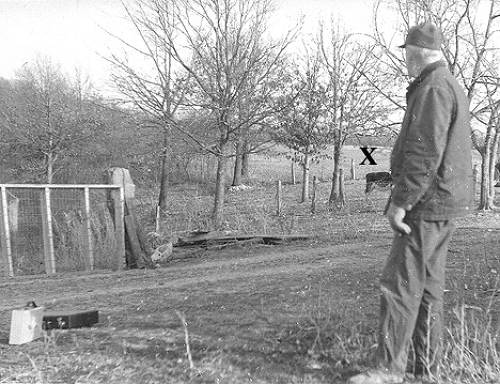
20 Claude looking at site of UFO marked by X
Here is an aerial photo marking the landing area of the UFO (photo 21):
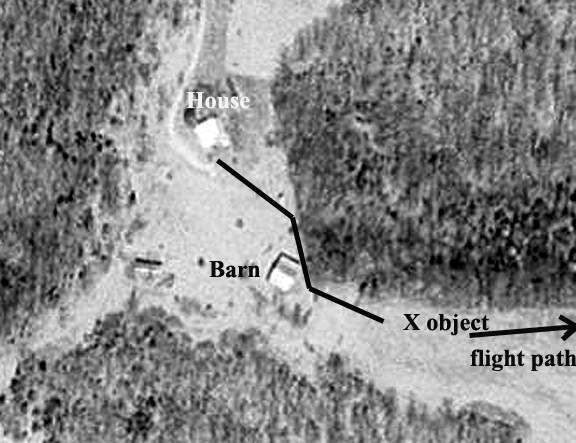
21 Landing area of Aliens
Edwards estimated that he was separated from the odd entities by about 70 feet of land, two wire fences, and a smattering of cows. The gutsy farmer was not pleased by the fact that his cows were being spooked or that his property was being trespassed on, even if said trespassers happened to hail from out of this world. The farmer, no doubt fueled by a combination of curiosity and adrenaline, climbed the first gate and started walking directly toward the ostensibly alien interlopers (photo 22).
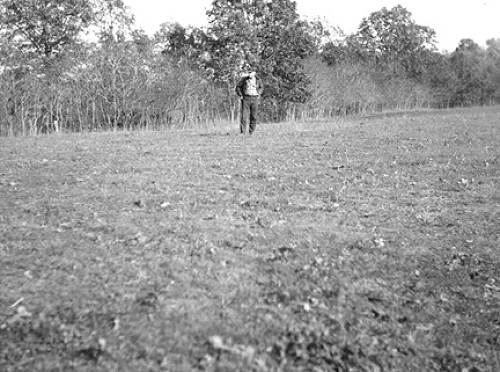
22 Location where Claude started toward UFO
As Edwards reached the second gate, the diminutive creatures began moving in an even more agitated fashion. Edwards would later describe these miniature monsters as being approximately 3 feet in height and having a grayish green complexion much like their “ship” although (based on his own drawing) it would seem that these beings erred on the greenish side a bit (photo 23).

23 Claude's sketch of Aliens
Also (based again on Edwards’ sketch) it would seem that either these beings had no hands or that their arms were moving too swiftly for Edwards to discern the shape of the appendages. Edwards also claimed that these aliens were either wearing goggles or had large wide set black eyes.
They also had dark protuberances where their noses and mouths ought to have been. Whether or not he believed the protrusion to be a natural part of their physical features or some sort of protective (or possibly breathing) apparatus is not clear.
Although the connection may be tentative at best, when hearing a description of the Tuscumbia aliens it is difficult not to have it invoke memories of an encounter reported by a pair of Finnish lumber jacks in 1971. The allegedly alien life form that they ran into on that wintery day near Kangaskyla was a small, almost lighter than air creature, which would come to be known as the Kinnula Humanoid. This being was said to be clad in a green colored protective suit similar to the creatures that Edwards bore witness to. That is assuming, of course, that the things that Edwards saw were wearing anything at all.
Edwards watched in wonder as these bizarre creatures buzzed back and forth directly beneath the odd device, arms swinging frantically at their sides. He would later claim that these “invaders” resembled little, green penguins, with no visible necks. Edwards also stated that he could not clearly discern what manner of locomotion they were employing with their lower extremities.
At this point, like any primal man defending his property minus weapons, he picked up a pair of bulky rocks and approached what, at this point, he was convinced was a UFO. In fact, Edwards would later state that his intention was to use the rocks to throw at the device and puncture holes in its side in order to prevent it from taking off.
As the farmer got within 15 feet of the “mushroom” and the energetic entities, he was abruptly stopped by some sort of “force field.” Edwards claimed that he could neither see nor tangibly feel it, but that the pressure the invisible barrier emitted was unmistakable.
According to Edwards: “I thought I was going right up to it. I got up there and there it was. I just walked up against a wall.”
It was then that Edwards (who would eventually sketch the domed vehicle) got his first good look at the soundless, glinting vessel. He would later describe the metallic surface of the vehicle as being smooth and seamless, even going so far as to compare it to “shiny silk.” He estimated that the curved top of the craft was about 18 feet in diameter and nearly 8 feet at its apex. The stem like tube that was supporting the object was evidently made of the same material as the domed top and stood not much higher than the beings beneath it.
At this point the perplexed farmer could also discern evenly spaded oval portals…about 12 inches long and 12 inches apart, situated around the lower rim of the “saucer.” Edwards would insist that these portals did not seem to function as windows as he could see a dazzling array of colors radiating from each side of the ovals. The colored lights oscillated as if they were spinning behind the portals. Edwards described the craft:
“The object just looked like a big shell, grayish green looking outfit. And underneath there were oblong holes where the lights were coming out. They were so bright you couldn’t see when you got up there…as if a color wheel was turning inside the thing.”
Anxiously, this rugged man of the land backed off about 10 feet, then hurled one of the rocks he had gathered at this immobile object. The rock bounced off the imperceptible barricade noiselessly and landed on the ground. Edwards then threw his second rock with even more force, but this one just skipped over the object like a stone over water, before landing in the field behind the UFO (photo 24).
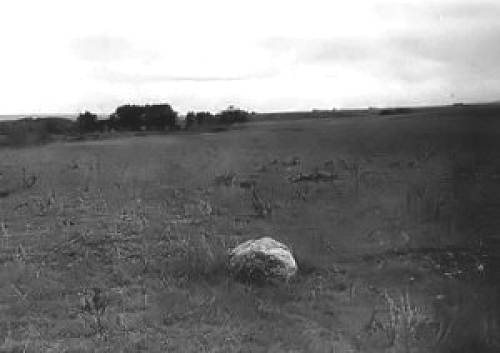
24 Large rock in field thrown by Claude
As soon as he lobbed the second stone, the scuttling, green critters swiftly disappeared behind the shaft supporting the craft, presumably into an access portal that was concealed from the farmer. It was then that the strange UFO tilted toward him not once, but twice. On the third lurch the UFO actually began silently ascending off the frozen earth.
According to Edwards, the flying mushroom soared skyward at tremendous speed before it leveled off and began heading toward St. Elizabeth, which is located southeast of Tuscumbia. The vehicle vanished within moments leaving behind a puzzled Edwards and a pasture full of befuddled bovines. Edwards later encapsulated his fantastic encounter for UFO investigator Ted Phillips:
“The whole thing took over five minutes, maybe ten. I have never seen anything like it. It looked like a shiny silk or something. I couldn’t tell. I was going to tell though if I could have hit it with that rock.”
One detail that would seem to add a stroke of veracity to this admittedly bizarre account is the fact that Claude Edwards was a seasoned man of the land who stood to gain very little…except for the ridicule of his peers…by admitting to this potentially harrowing event. In fact, when Phillips was introduced to Edwards through his brother, the farmer refused to utter a word about the incident until the young researcher pledged to protect the farmer’s anonymity, which he did until Edwards’ death. Phillips described his first encounter with Edwards:
“When I arrived at the farm we visited for several minutes gaining his confidence that I wouldn’t reveal his name or location until his death. He didn’t like talking about the sighting at first, but became more comfortable as we discussed the weather and farming. I asked him to relive the event in real time and we began on his front porch which faces the large barn near the landing area.”
The fact that this farmer never tried to squeeze an ounce of publicity or make a penny of profit from his strange Valentine’s Day experience has lead many investigators to conclude that there would be no motivation for a prank on the part of Edwards. In further support of Edwards’ claim is the uncanny trace evidence left behind in the field where the UFO had landed.
Phillips, who arrived to interview Edwards not long after the events in question, was able to photograph the effects this UFO had on the field, including the spot where the support tube had met the soil (photo 25).
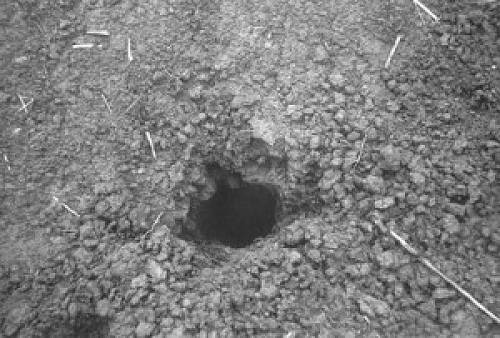
25 Hole in ground made by one of Landing Arms
Phillips explained:
“When I arrived at the site, the traces were still quite visible. It was one meter in diameter in a slightly irregular circle where the shaft had rested. The soil was extremely dehydrated in contrast with the surrounding soil.”
This would be the last encounter that Edwards ever reported with these peculiar space penguins and their mushroom shaped UFO, but I’d say it is a safe bet that as he stepped out of his modest home at the crack of dawn to begin his work week every morning, that he never did so without looking out at that field with some apprehension…and perhaps just a bit of anticipation.
Well, I don’t have an explanation about this episode of Claude and the UFO; he certainly was not one to tell such stories according to his cousin Doris Edwards Wyrick. Of course, all the UFO crowd has taken the story and run with it, numerous references about it are on the web as I stated above.
We have in our Miller County music display four different instruments featured which are found in about any Ozark Hill Country music band. Harold Flaugher recently arranged the instruments in a group next to our Lee Mace’s Ozark Opry display. Here is a photo of the instruments in which Harold (on the right) is accompanied by his life long time friend, Harold Hawk (photo 26):
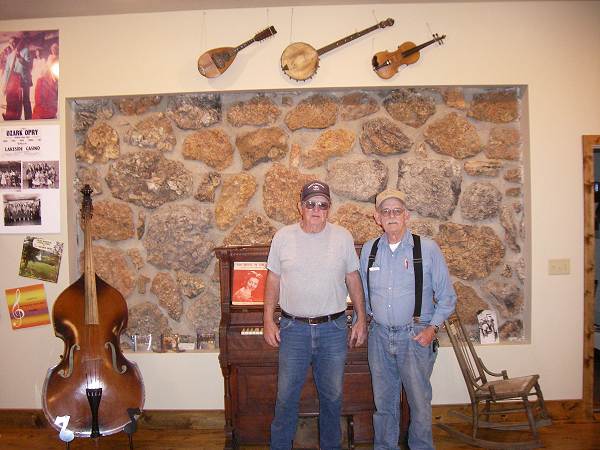
26 Harold Hawk and Harold Flaugher
To the left of Harold Hawk is a bass Guitar which belonged to Lee Mace (photo 27).
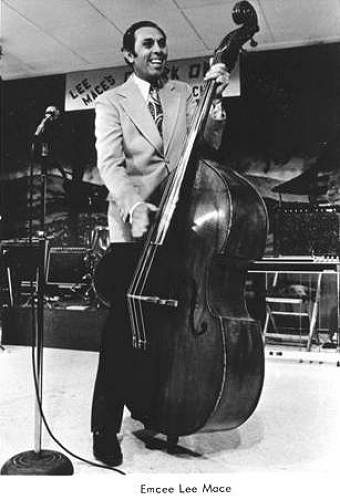
27 Lee Mace with Bass Guitar
In a row above Harold and Harold from left to right are a 12 string mandolin originally owned by Virgil Clark of Eldon (photo 28), a five string Vega banjo originally owned by Omer Robinette of Brumley (photo 29), and on the far right a fiddle once owned by Elmer Flaugher, father of Harold Flaugher (photo 30).
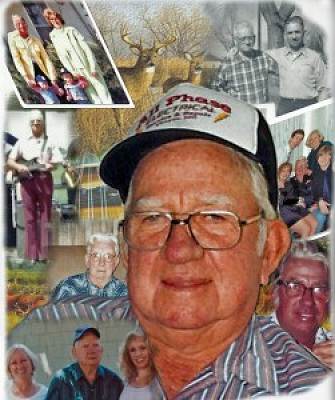
28 Virgil Clark

29 Omer Robinett
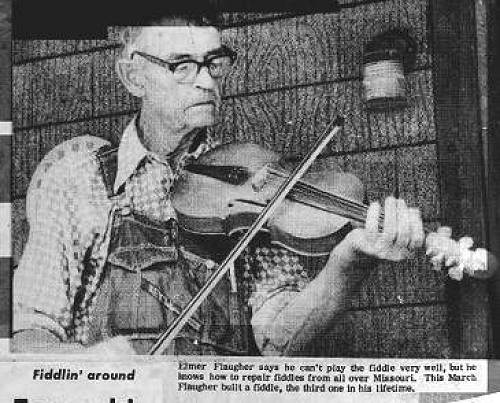
30 Elmer Flaugher
The only instrument missing is a guitar.
Harold Hawk’s younger brother, Roger Hawk, who now lives in Florida, is one of Miller County’s better guitarists (photo 31).
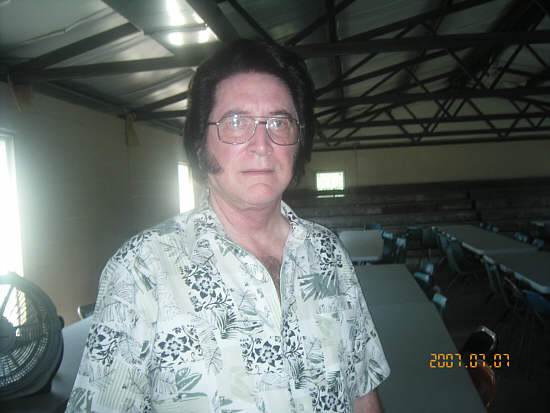
31 Roger Hawk taken at Hawk Reunion - 2007
Roger, who attended school in Tuscumbia, became a noted Nashville guitarist and for years was George Jones' guitarist during the time George had his biggest hits.
Harold Hawk tells me that George and Roger remain best of friends and that George is a frequent visitor at Roger’s home in Florida. Roger still performs with his own group in Florida.
Roger was a few years younger than I but I remember him well because when we were in school he lived in the valley below my home. I remember watching and listening to him playing guitar at Richard Hill’s home back when all of us were learning to play. Even at that young age, Roger’s dexterity at fingering the notes on the guitar was unbelievably accomplished. Harold said his brother was playing a guitar at the age of three!
I copied from Roger’s website this short biography:
ROGER HAWK
“Roger is from the Ozark hills of South Central Missouri, in the river town of Tuscumbia. He was born to be a musician, receiving his first guitar at age 7 and learning to play rhythm. His musical family encouraged Roger with his talents to play and sing, not only with the family but also in church. Roger continued to excel at music and started playing steel guitar at age 12.
Roger’s first professional exposure was on KRMS radio in Osage Beach, Missouri, when he was 13 years old. He knew that music would be his life, from that moment on.
Roger was in numerous well respected gospel groups. The Mid Statesmen out of Kansas City, Missouri and the Voyagers quartet from Jacksonville, Florida were two of those groups.
Roger has had an exciting music career with many amazing experiences. He spent many years playing music with the legendary George Jones. Traveling with the Jones band gave Roger the opportunity to travel and play music with such great talents as Conway Twitty, Merle Haggard, Loretta Lynn, Tanya Tucker, and the Statler Brothers. Roger feels blessed and honored to have been involved with so many gifted musicians.
After leaving the fast paced road life a few years ago, Roger took a break from music but having a true musician’s heart, it wasn’t very long before he was eager to strap his guitar back on. Roger explored several musical outlets but in 2004, he formed the idea of a family friendly, “opry style” show, now known as “Roger Hawk & the Dixie Angel Band.” Today, Roger is dedicating music entirely to Elvis. His new band is “Roger Hawk and Mystery Train.”
That’s all for this week.
 Joe Pryor
Previous article links are in a dropdown menu at the top of all of the pages.
|

